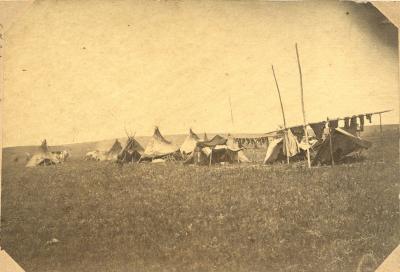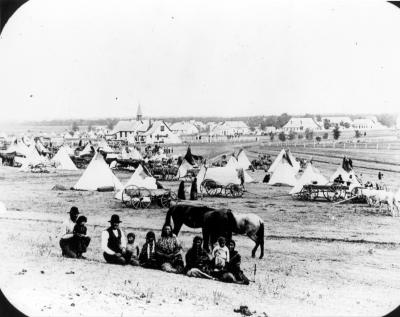 "[Officials] built a box and put the beef in it and steamed it and made soup . . . and that is the reason these hills here are filled with children’s graves; it seemed as though they wanted to kill us.
"[Officials] built a box and put the beef in it and steamed it and made soup . . . and that is the reason these hills here are filled with children’s graves; it seemed as though they wanted to kill us.
Passing Hail, Mdewakanton Dakota, to a congressional commission investigating conditions at Crow Creek, 1865
Acts of Congress in February and March 1863 abrogated, or revoked, all treaties between the U.S. government and the Santee Dakota. As a result, all but a few protected groups of Dakota were exiled from Minnesota. Minnesota’s Ho-Chunk Indians living in Blue Earth County near Mankato--eleven of whom were tried for participation in the war--were also expelled from the state. This expulsion ushered in an era of bare survival for the Dakota, as well as the disintegration of many families.
In May of 1863 1,300 Dakota were loaded onto steamboats and sent to Crow Creek reservation. Crowded onto the boats and weakened by imprisonment, many died on the voyage. The new reservation was desolate and food was scarce. In the first six months at Crow Creek more than 200 Dakota people died, most of them children.

John Williamson, the son of missionary Thomas Williamson, accompanied the Dakota to Crow Creek and was instrumental in their survival. During the winter of 1863, he convinced Colonel Thompson to allow some of the Dakota men to go on a buffalo hunt, which furnished them with enough meat to last through the winter.
"It is not starving to death here yet, but it is starvation all the time."
John P. Williamson, Crow Creek, Dakota Territory, January 6, 1864
Contemporary Comment:
"By the time they were sent to Crow Creek, most of the people left were women. A lot died along the way, a lot died when they got here. I've read lots of journals from soldiers and missionaries. One of the soldiers mentioned that the women would go to the horse corrals each morning and pick grain from the horse feces to feed their children. A lot of honorable women also had to resort to prostitution to feed their children. These are the things they were forced to do. To us Dakota people, women are sacred, and should be treated as such. I want to make sure they're recognized for their strength, perseverance, wisdom, and intelligence."
Peter Lengkeek, Crow Creek, 2011
Hyman, Colette A., "Survival at Crow Creek," Minnesota History, 61 (2008), 148-60.
Multimedia
Steil, Mark. Exiled at Crow Creek. Minnesota Public Radio.
Secondary
Hawker Bakeman, Mary and Richardson, Antonia M., editors. Trails of Tears: Minnesota’s Dakota Indian Exile Begins. Roseville, MN: Prairie Echoes Press, 2008
Hyman, Colette A., "Survival at Crow Creek," Minnesota History 61 (2008), 148-60
Waziyatawin. What Does Justice Look Like? St. Paul: Living Justice Press, 2008




